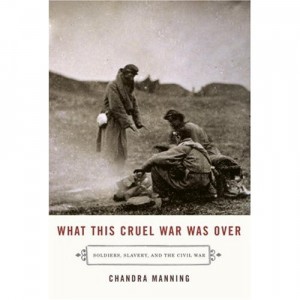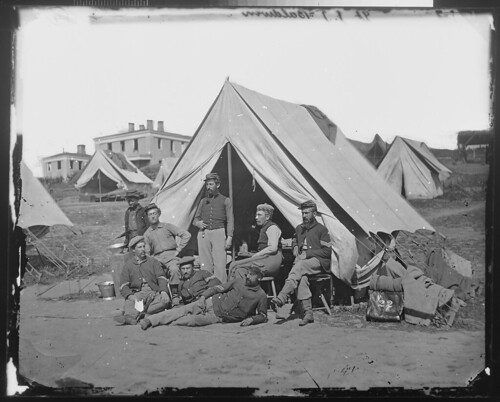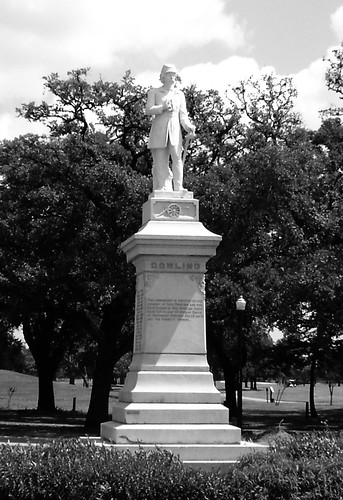Thanks to all of you for your thoughtful discussion of the Manning book on Thursday during class, as well as on your group blogs. Mercy has a good round-up highlighting some of the points made in that discussion; check it out if you haven’t already.
One of the points that came up both in class and on the blogs, and which seemed to underlie some skepticism about Manning’s argument, is the point that Northern soldiers seemed to express as much racial prejudice–particularly at the start of the War–as their Southern counterparts. Yet Manning seems to emphasize the motivating power of those prejudices more in the case of the Confederates fighting to defend slavery than in the case of the Union soldiers fighting to abolish it. Why?
 An important point to remember here is an distinction that Manning makes throughout the book between support for emancipation and support for racial equality. As she shows time and again, it was possible for Union soldiers to come to support emancipation without believing in racial egalitarianism. As she puts it, in the Union ranks, “antagonism toward slavery rarely meant support for equal rights for African Americans” (p. 79). Yet this didn’t necessarily diminish Union soldiers’ hostility toward slavery, because they “sought to separate the issue of slavery from the more complicated questions of black rights and racial equality” (pp. 79-80). According to Manning, the difference between most Union and Confederate soldiers was that Confederates could not conceive of such a separation, whereas Union soldiers could. While there was a “small number” of nonslaveholding Confederate soldiers who started to voice antagonism towards slavery, particularly in late 1863 when Confederates’ disillusionment with their government swelled, those doubts never seriously undermined Confederate soldiers’ “commitment to slavery” (see pp. 138-141). The primary reason, according to Manning, is their inability to separate the abolition of slavery from the abolition of racial hierarchy. Union soldiers, on the other hand, often kept those issues separate.
An important point to remember here is an distinction that Manning makes throughout the book between support for emancipation and support for racial equality. As she shows time and again, it was possible for Union soldiers to come to support emancipation without believing in racial egalitarianism. As she puts it, in the Union ranks, “antagonism toward slavery rarely meant support for equal rights for African Americans” (p. 79). Yet this didn’t necessarily diminish Union soldiers’ hostility toward slavery, because they “sought to separate the issue of slavery from the more complicated questions of black rights and racial equality” (pp. 79-80). According to Manning, the difference between most Union and Confederate soldiers was that Confederates could not conceive of such a separation, whereas Union soldiers could. While there was a “small number” of nonslaveholding Confederate soldiers who started to voice antagonism towards slavery, particularly in late 1863 when Confederates’ disillusionment with their government swelled, those doubts never seriously undermined Confederate soldiers’ “commitment to slavery” (see pp. 138-141). The primary reason, according to Manning, is their inability to separate the abolition of slavery from the abolition of racial hierarchy. Union soldiers, on the other hand, often kept those issues separate.
This is an important point to remember, especially because in retrospect it may seem hard to grasp how someone could fervently desire the abolition of slavery and just as fervently oppose racial egalitarianism. Yet this was a viable and quite prevalent position throughout the Civil War North. As a result, pointing out the presence of racism in both the North and the South does not by itself undermine Manning’s evidence that many Union soldiers came to support emancipation, nor does it prove that Confederates, simply by holding some of the same racial views as their Northern counterparts, must have had the same point of view about slavery as well.
Shifting gears for a moment, it’s also important to think about why slaveholders in the Confederacy fought, even though the prompts for Blog Post #3 asked you to focus on the question of non-slaveholders’ motivations. The question of slaveholders’ thinking about the coming of the War is addressed in an interesting recent post by historian Louis Masur on the New York Times blog, “Disunion.” I’d encourage you to take a look at Masur’s close analysis of “A Slaveholder’s Diary,” and I also recommend the “Disunion” blog more generally. The Times has commissioned a great group of writers who are publishing regular posts on the war throughout the year to mark the sesquicentennial of the war.
The Washington Post has a similar blog called House Divided, and on this blog, Manning–a professor at Georgetown University–is actually a regular contributor.
Bookmark these two blogs or add them to your RSS readers, and you’ll be sure to have some interesting reading material that can complement our course readings and even provide you with evidence to use for your blog posts!




 Your second blog post assignment is based on the assigned reading for this week. You should read pp. 1-55 of Thomas Brown’s The Public Art of Civil War Commemoration and use specific evidence and examples from that reading when writing your comment. This book is a required text and is available in the Rice University bookstore and on 2-hour reserve at Fondren Library.
Your second blog post assignment is based on the assigned reading for this week. You should read pp. 1-55 of Thomas Brown’s The Public Art of Civil War Commemoration and use specific evidence and examples from that reading when writing your comment. This book is a required text and is available in the Rice University bookstore and on 2-hour reserve at Fondren Library.